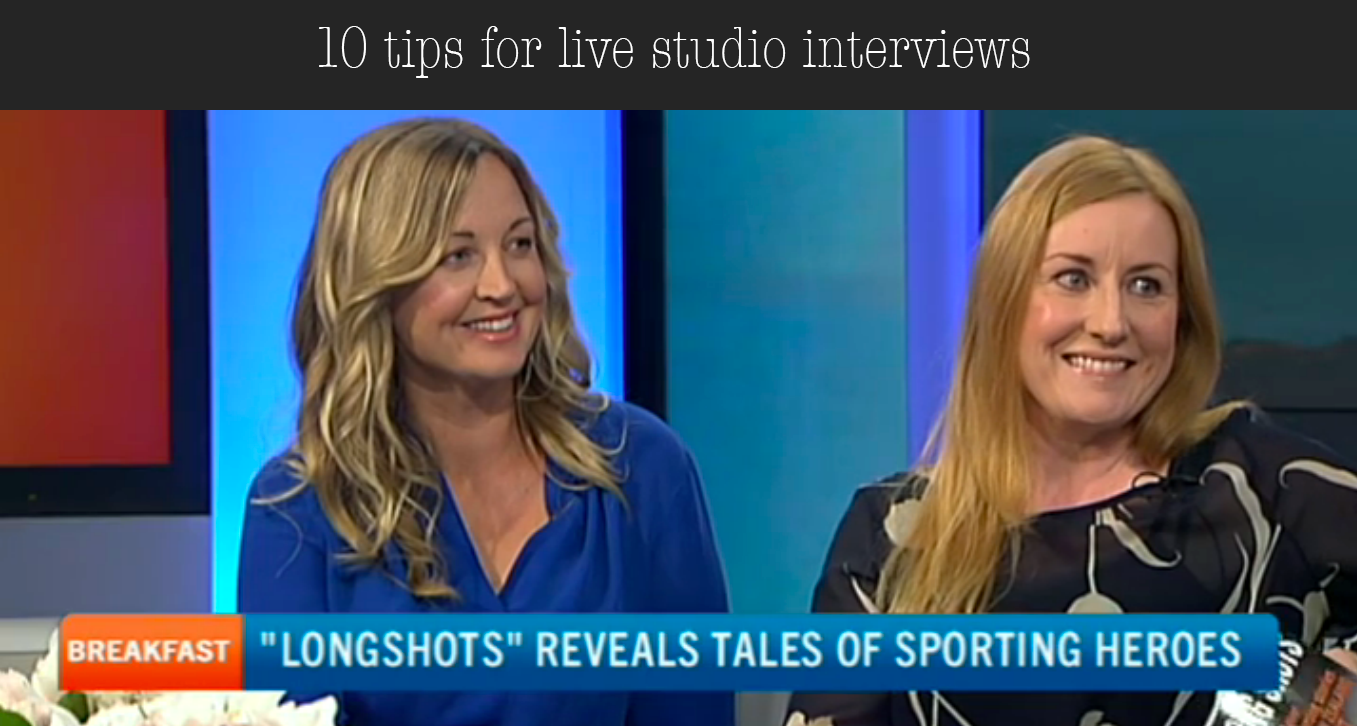The opening question should have been an easy one: How did we come to write our book, Long Shots?
I leaned forward on the couch, heart aflutter. This was my first live television interview and I was nervous to say the least. Deep breath, Go.
“Well we came across the story of Formula 1 driver Denny Hulme racing in the Can-Am series with devastating burns, just 12 days after the death of his friend and team-mate, Malcolm McLaren…”
Malcolm Maclaren! Noooooooo!! I meant Bruce McLaren! Bruce, the famous Formula 1 driver, not Malcolm the infamous manager of punk rockers, the Sex Pistols.
It’s been a year now and I still flush when I remember that face palm moment.
Doing live TV was a major step outside my comfort zone – but an essential one. My first book, Long Shots (co-written with my friend Bronwyn Sell) had just been released and we were fortunate to be invited to promote our work in several live TV and radio interviews.
I’d worked behind the scenes in telly for years and conducted many interviews as a freelance writer, but putting myself in the guest’s chair was something else altogether. In the car on the way to the studio I’d literally been saying to myself, “Remember it’s Bruce, not Malcolm McLaren.”
Rookie mistake. Never reinforce something you don’t want to say.
But you know what? I simply laughed, corrected myself and carried on.On the whole the interview worked out really well – and my gaffe certainly made us memorable. With each interview, it got easier and easier and I’ve since gone on to do a number of podcast interviews about my business.
While I’m no expert, I’m often asked for tips by entrepreneurs preparing for their first live interview. To be clear, I’m not talking about controversial interviews, where you are asked to justify your position or go head-to-head with someone of an opposing view. I’m talking about opportunities to promote your work.
Here’s my top ten tips:
- Do your homework – no one wants to end up like New Zealand Prime Minister John Key, who got taken by surprise in a recent shock Jock radio show when the questions took an unexpectedly, ahem, personal turn – earning him a lampooning on the John Oliver show. Be sure to watch or listen to the show for a few days beforehand, so you can be familiar with the kinds of questions you are likely to be asked. Think about the audience and how they would like to see the information presented, so that you can pitch your answers appropriately.
- Try to find out the presenter’s specific interests. When the interview is booked, ask the producer if there are any specific topics of interest.There were 25 different stories in our book and about 6 months had lapsed between finishing the book and sitting down for the live interviews. Knowing which stories interested the presenter allowed us to refresh our memories on the details to ensure a lively and engaging discussion. Things won’t always go according to plan and the conversation may take a different course, but asking beforehand allows you to concentrate your preparation.
- Presentation is key – Don’t wear stripes, spots or houndstooth patterns as they can look distorted on camera. Go for something comfortable in a colour that suits you – you don’t want to be fussing with an awkward neckline or a bulging muffin top over too tight pants. And avoid jangling jewellery, short skirts or anything that will distract the viewer from what you have to say. If there’s enough time, splash out on a hair do. When you look you’re best, you’re going to feel more confident and that will shine through.
- Know your three key points – Live interviews go fast and it’s easy to get distracted from your main message. So think like a politician – prepare three key points that you’d like to cover and where possible, try to bring the conversation back to those points.
- Rehearse some stock answers – Ask a friend to help you practice some answers to key questions – for example your backstory; how you came to launch this product or business; the most important things people need to know about it; or the most common problems you see people struggling with in your field of expertise and your top tips for working through those challenges. Think like a school English exam and have a couple of great examples you could adapt to a range of questions.Don’t memorise your answers – you don’t want to be spouting off obvious PR or reinforcing the wrong info, as I did. But you do need to be able to express the key ideas succinctly and clearly – and the best way to do that is to practice.
- Don’t be afraid to dodge’em – Be clear in your mind on any no-go areas (such as family or personal relationships), and think of a way to elegantly deflect each topic.There may also be some questions that are just too difficult to answer off the cuff. Make a list of the five curliest questions you could (but most likely won’t) be asked and have an answer in mind for each one.
In one of our live radio interviews, we were repeatedly asked why we hadn’t included person A; why we’d favoured person B over person C; and why we hadn’t featured say, an obscure regional cricket match from 1972. Now it’s much easier to talk about those who did make the book, than to debate the merits of the thousands of sports people who didn’t make the cut. Rather than get into an awkward discussion comparing individual sportsmen and women without all the facts on hand, we simply made the point that there was more than enough material for a second volume and then steered the conversation back to the criteria we had used to select the strongest stories. - Slip in your company or product name – Try to throw in your business name, or your book title as a natural part of the conversation. For example, “I started XYZ Florists because…” or “Long Shots is really all about…” That will help reinforce your brand in the audience’s mind. Just don’t overdo it, or it starts to look unnatural and contrived.
- Know what’s in the news – if there is something topical or relevant happening, you may like to bring it into the conversation – or the presenter might ask you about it. Our television interview took place on Melbourne Cup Day, and one of the stories in the book concerned a famous Melbourne Cup race. The producer found the footage and used it elsewhere in the programme, earning our book an additional brief spot in the show.
- Breathe – Practice a little mindfulness or deep breathing in the green room, to get yourself poised and ready before you walk on set. And remember you don’t have to rush – take a deep breath before you answer any question and try not to interrupt the presenter or other guests.
- Remember it’s just a conversation – Ignore the cameras and the recording equipment and concentrate on having a lively discussion with the person in front of you. That’s all it is. And if you make a gaffe – as I did – just smile, correct your mistake and keep on going.
Most of all, relax and have fun. This is a wonderful opportunity to promote your work and the more interviews you do, the easier it will become.
Have you ever given a live interview? Share your best tips – or your face palm moment – in the comments below.
Wanna see my memorable moment? You can see the interview here.





